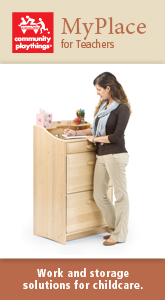ExchangeEveryDay Past Issues
 << Previous Issue
| View Past Issues | | Next Issue >>
<< Previous Issue
| View Past Issues | | Next Issue >> -Lily Tomlin
In their book, From Play to Practice, Marcia Nell and Walter Drew shared these observations on play and language:
"People communicate ideas or information with others in a variety of ways. Language is the most common tool used during this shared meaning-making process. Sometimes, however, there are language barriers that hinder the process of communication, such as when people do not speak the same language or a person has special needs that limit the sharing of thoughts with others. For children, play supplies a context to overcome these types of communication barriers.
"When children are learning a second language, they are actually acquiring two types of language. The first type is called... cognitive academic language proficiency (CALP). This is the language used in textbooks and classroom settings. The second type, called basic interpersonal communication skills (BISC), is the language children use in social situations, such as on the playground or with their friends.... Play can aid in the acquisition of social language skills, which enables dual language learners to interact with their peers while they continue to acquire the academic language skills necessary for learning and participating in classroom activities. During social play with peers, children surmount language barriers by using gestures or other nonverbal cues in order to continue the play. It is play's intrinsic motivation that enables children who speak different languages to continue their play experiences and to share meaning."
 How do we help teachers deepen their understanding of the importance of play? How do we strengthen teachers' ability to skillfully and intentionally guide children's learning through play?
How do we help teachers deepen their understanding of the importance of play? How do we strengthen teachers' ability to skillfully and intentionally guide children's learning through play?When teachers engage in creative, open-ended play experiences, they learn firsthand the power of play. They also become more knowledgeable about the purposeful use of materials and intentional teaching strategies they can use to help children engage in open-ended play.




Comments (1)
Displaying 1 CommentDr. Drew's Blocks/Institute for Self Active Education
Melbourne Beach, FL, United States
Well, thank you for sharing the passage on play and the development of language. I was thinking of Loris Malaguzzi and the Hundred Languages of Children,...then I thought about how open-ended objects support and encourage the language of forms, three dimensional expressions of thoughts, feeling, ideas, etcetera. The uniqueness of physical objects stimulates visual representations of the minds content which encourages and sustains engagement of spatial language which helps to inspire further expression using spoken language. From Play to Practice is a really wonderful book. Thanks again for sharing it. Please say hello to Bonnie and Roger,...Love, play, peace
Post a Comment